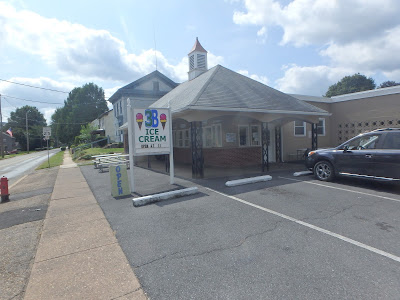When I checked in, the hotel manager listened to my tale of woe and then cheerily assured me that Ely, Nevada, was indeed at the edge of a Bermuda Triangle for automobiles. The shop where I should take the Ion, she said was Big 8 Tire Auto, and I should ask for Junior. "He's my brother," she confided. "Tell him I sent you."
Somewhat scrambled departure from Grand Junction this morning; I doubled back to retrieve my tablet computer, only to find that Laurie had leaped into her car with it, intending to catch up with me at the service station when I stopped to refuel. All's well that ends well ... tablet retrieved, another opportunity to thank Laurie and say goodbye to Negrita.
I drove to the service station, refueled, adjusted tire pressures, and checked the oil level. It was low again, so I dug out another quart from my stash in the trunk. Joys of owning older cars, &c.
Thirty miles later, welcome to Utah! First warning sign, "EAGLES ON HIGHWAY". Alao falling and fallen rocks, apparently, but all I saw were orange barrels marking the road work in progress. Ah, well, I didn't have much hope that I would be able to clear the salt flats before noon.
Seventy miles into Utah, US 50 started its climb into the geologically fascinating Capitol Reef region of massive seabed sections lifted up on an angle along a hundred mile long fold in the earth's crust. The Ion drive train took the moderately steep climb in stride without dropping below 55 mph, but the air conditioner struggled in its battle with the high-90s heat.
Here's one of the photos I took of the San Rafael Reef during a rest stop; the rest will have to wait untill I have a better uplink. This is definitely a place worth some more wandering -- but not in August.

Descending from 7860 feet to pass Sevier Lake, I continued across the last few miles of Utah's desert, passing by the renowned Salt Flats of car speed racing fame and -- as the car's air conditioner labored -- looking ahead for Nevada's mountain ranges.
Then the low oil alarm went off. Fast stop! Engine temperature still in range, fortunately, but a definite hot oil smell. I stepped out into the early afternoon heat, checked the dipstick. Dry. More oil so I could reach the next service station? No, that was the last one in my stash.
Okay. Emergency cell phone? No, no service.
Right. I put tablet, phone, travel wallet, and a bottle of water into my daypack -- no towel, a crucial omission -- tucked in my shirt, set my straw hat on my head, and hung out my thumb for a ride. Good thing I've been practicing during my AT hikes, yes?
A young couple out on a ramble to Carson City stopped and generously agreed to take me to the next service station to the west. That turned out to be 95 miles and two construction zones away in Ely.
I bought four quarts of oil, and then checked online for a taxi or any other public transit option for the return trip. Nada, nicht, nikto nichevo.
"A taxi from Ely?" the clerk at the register said, and shook his head with a tight smile. "Can't help you there." Another associate, though, heard my request, and suggested that he would be finishing his work shift in a few minutes and would be happy to drive me back. Good fortune! But ... about three hours round trip, I cautioned, and offered reimbursement for his trouble. Nathan waved that away, though he did let me pay for refueling his car.
I made it back to Ely at 7:45 pm. Assuming that this town's name has the same Scriptural origin as Eloy, Arizona's oft-cited desert town of despair, I would say that in ths place and on this day, my God did not forsake me, instead showing once again how many good and generous people there are in the world. Deo gratias.
I plan to post a schedule update tomorrow after Junior has checked out the Ion's oil concerns.
































